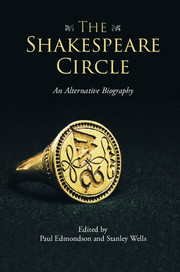Part I - Family
Published online by Cambridge University Press: 05 November 2015
Summary
The closest members of the Shakespeare circle are his family. This section covers four generations. Starting with his mother, Mary Arden, the youngest of eight children, we are reminded by Michael Wood of a ‘shift in wealth, education and opportunity which marked the later Tudor age’. It was Shakespeare's family who first stimulated his imagination and creativity by introducing him to the rhymes and folk tales of oral tradition. Helen Cooper, an authority on the late medieval influence on Shakespeare, has suggested to us that from his early years he knew tales such as those about Robin Hood and King Arthur as well as the romances of Guy of Warwick (all of which were widely disseminated orally and readily available through inexpensive editions). The presence of casual allusions to many of these tales in plays written much later in life – Edgar disguised as Poor Tom in King Lear, for example, alludes to the romances of Bevis of Hampton – suggests that they were deeply embedded in his imagination.
The medieval imagination was inextricably linked with the old faith, inevitably represented to Shakespeare by his parents. The Church of England, established during their formative years, was Catholic in the broadest sense of the term. The three Catholic creeds, along with ‘The Song of the Blessed Virgin Mary’ (‘the Magnificat’) and ‘The Song of the Three’ (‘the Benedicite’), were printed in its foundational text, the Book of Common Prayer, first printed in 1549. It was always intended to be a broad church – one which was catholic and reformed and could accommodate a wide-range of spiritual and religious beliefs among those who were happy outwardly to conform. Overall Shakespeare and his family, like most other people of their time, seem to have done just that.
An interpretative clash in this section concerns John Shakespeare. David Fallow's revisionist view of the later part of his life and career finds a life of impressive prosperity deriving from his involvement with the thriving wool industry, whereas Michael Wood accepts the more traditional view that his withdrawal from his civic duties reflects a decline in his economic fortunes. In marrying into the Ardens, John Shakespeare allied himself with a junior branch of a prosperous land-owning family of good pedigree.
- Type
- Chapter
- Information
- The Shakespeare CircleAn Alternative Biography, pp. 9 - 12Publisher: Cambridge University PressPrint publication year: 2015

